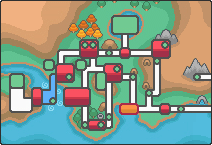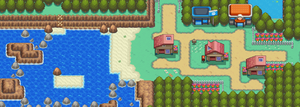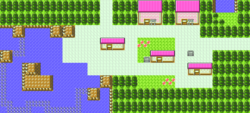- Yoshino redirects here. For the character related to Professor Cerise and Chloe, see Talia.
Cherrygrove City (Japanese: ヨシノシティ Yoshino City) is located in south-central Johto. Though the city has no Gym, it is frequently passed through by Pokémon Trainers on their way to Violet City from New Bark Town via Route 29 in the east. The city acts mainly as a tutorial, introducing the player to the main tools of the game (the Pokémon Center, the Poké Mart, etc.).
Slogan
Generation II
The City of Cute, Fragrant Flowers (Japanese: かわいい はなの かおる まち The city of cute, fragrant flowers.)
Generation IV
The City of Fragrant Flowers (Japanese: はなのかおり ただよう まち The city with a waft of fragrant flowers.)
Places of interest
City Tour
Guide Gent (Japanese: あんないじいさん Guide Old Man), who first stands near the east entrance of Cherrygrove City, will offer the player a tour of the city. The tour route includes the Pokémon Center, the Poké Mart, the exit to Route 30, the sea, and Guide Gent's house. Upon the conclusion of the tour, the player will receive the Map Card for their Pokégear. In HeartGold and SoulSilver, he instead gives the player the Running Shoes, and only gives them the Map Card upon leaving Cherrygrove City to the north.
Guide Gent's House
Full-of-Energy, High-Speed Old Man
Off-shore island
There is an off-shore island to the west of the town. Trainers are unable to reach the island when they first reach the town, due to the fact they are unable to use Surf. There is a man who will give the player the Mystic Water. In Pokémon HeartGold and SoulSilver, a strip of land north of the island has a hidden Nugget, which requires HM08 (Rock Climb) to reach.
Demographics
Pokémon Gold, Silver, and Crystal
In Pokémon Gold and Silver and Pokémon Crystal, Cherrygrove City has a total population of 18.
Pokémon HeartGold and SoulSilver
In Pokémon HeartGold and SoulSilver, the population of Cherrygrove City is 22, making it the second-smallest settlement in Johto, the smallest being New Bark Town. It is the smallest city in the Pokémon world.
Poké Mart
The Poké Mart is to the left of the Pokémon Center.
| Lower cashier (Generation IV)
|
|
|
|
|
|
|
|
|
|
|
|
|
|
|
|
|
|
|
|
|
|
|
|
|
|
|
|
|
|
|
| Upper cashier (Generation IV)
|
|
|
|
Items
Pokémon
Generation II
| Pokémon
|
Games
|
Location
|
Levels
|
Rate
|

|

|

|
| Surfing
|
|
|
G
|
S
|
C
|
|
20-24
|
60%
|
|
|
G
|
S
|
C
|
|
15-19
|
30%
|
|
|
G
|
S
|
C
|
|
20-24
|
10%
|
| Fishing
|
|
|
G
|
S
|
C
|
|
10
|
15%
|
|
|
G
|
S
|
C
|
|
10
|
85%
|
|
|
G
|
S
|
C
|
|
20
|
55%
|
|
|
G
|
S
|
C
|
|
20
|
0%
|
0%
|
10%
|
|
|
G
|
S
|
C
|
|
20
|
35%
|
|
|
G
|
S
|
C
|
|
20
|
10%
|
10%
|
0%
|
|
|
G
|
S
|
C
|
|
40
|
60%
|
|
|
G
|
S
|
C
|
|
40
|
10%
|
|
|
G
|
S
|
C
|
|
40
|
0%
|
0%
|
30%
|
|
|
G
|
S
|
C
|
|
40
|
30%
|
30%
|
0%
|
| A colored background means that the Pokémon can be found in this location in the specified game. A white background with a colored letter means that the Pokémon cannot be found here.
|
Generation IV
| Pokémon
|
Games
|
Location
|
Levels
|
Rate
|

|

|

|
| Surfing
|
|
|
HG
|
SS
|
|
10-25
|
90%
|
|
|
HG
|
SS
|
|
15-25
|
10%
|
| Fishing
|
|
|
HG
|
SS
|
|
10
|
15%
|
|
|
HG
|
SS
|
|
10
|
85%
|
|
|
HG
|
SS
|
|
20
|
50%
|
|
|
HG
|
SS
|
|
20
|
0%
|
0%
|
10%
|
|
|
HG
|
SS
|
|
20
|
40%
|
|
|
HG
|
SS
|
|
20
|
10%
|
10%
|
0%
|
|
|
HG
|
SS
|
|
40
|
60%
|
|
|
HG
|
SS
|
|
40
|
10%
|
|
|
HG
|
SS
|
|
40
|
0%
|
0%
|
30%
|
|
|
HG
|
SS
|
|
40
|
30%
|
30%
|
0%
|
Headbutt
Group A
|
|
|
HG
|
SS
|
|
2-3
|
20%
|
|
|
HG
|
SS
|
|
2-3
|
50%
|
|
|
HG
|
SS
|
|
2-3
|
30%
|
Headbutt
Group B
|
|
|
HG
|
SS
|
|
4-5
|
20%
|
|
|
HG
|
SS
|
|
4-5
|
50%
|
|
|
HG
|
SS
|
|
4-5
|
30%
|
|
|
HG
|
SS
|
|
4-5
|
30%
|
Headbutt
The four trees on the hill by the sea. Accessible by surfing west into the water, then using Rock Climb.
|
|
|
HG
|
SS
|
|
18-20
|
65%
|
|
|
HG
|
SS
|
|
18-20
|
30%
|
|
|
HG
|
SS
|
|
21-25
|
5%
|
| A colored background means that the Pokémon can be found in this location in the specified game. A white background with a colored letter means that the Pokémon cannot be found here.
|
Trainers
Generation II
 If the player chose Chikorita:
If the player chose Chikorita:

|
|
Reward: $300
|
|
|
|
|
|
 If the player chose Cyndaquil:
If the player chose Cyndaquil:

|
|
Reward: $300
|
|
|
|
|
|
 If the player chose Totodile:
If the player chose Totodile:

|
|
Reward: $300
|
|
|
|
|
|
Generation IV
 If the player chose Chikorita:
If the player chose Chikorita:

|
|
Reward: $500
|
|
|
|
|
|
 If the player chose Cyndaquil:
If the player chose Cyndaquil:

|
|
Reward: $500
|
|
|
|
|
|
 If the player chose Totodile:
If the player chose Totodile:

|
|
Reward: $500
|
|
|
|
|
|
Walking Pokémon effects
When interacting with walking Pokémon in HeartGold and SoulSilver, the Pokémon may occasionally show an altered mood specific to this location.
- The walking Pokémon smells the scent of the flowers.
In the anime

Cherrygrove City in the
animeCherrygrove City appeared in Once in a Blue Moon, where Ash, Misty, and Brock visited it along the way to Violet City. The riverside location prides itself on its clean and green image. Officer Jenny ensures the integrity of the area's large Quagsire population, which are illegal to catch under the local Quagsire Preservation Restrictions. The Quagsire are highly revered by locals as bioindicators of water quality and symbols of good fortune. Every year, the Quagsire swim down from nearby Blue Moon Falls and take round objects from around the city as a part of a special lunar festival. The items float downstream and are believed to be blessed once returned; the final item is considered particularly lucky.
One of the round objects the Quagsire were interested in was the GS Ball. Ash was reluctant to let them have it, but ultimately, the slippery Quagsire made away with the item, though it was eventually returned by the river, along with the rest of the taken items, allowing Ash to recover it.
In Pokémon Ranger and the Temple of the Sea, Samiya was temporarily located in the sea south of Cherrygrove.
Alex Davis from Power Play! is from Cherrygrove City, as is Salvador, a Trainer who Ash battled in A Claim to Flame!.
In the manga
Pokémon Adventures
Cherrygrove City first appeared in Elekid Incorporated, where Policeman Falkner took Gold to the Cherrygrove police station to be questioned regarding the Totodile theft from Professor Elm's laboratory. Gold was told to give a description of the culprit, Silver, but as Gold believed Silver to be behind the theft of his backpack as well, he gave the police a false description so that he could deal with Silver by himself.
In Slugging It Out with Slugma, Professor Oak was revealed to have a second research center in Cherrygrove City, from which he sent Crystal out on her quest to complete the Pokédex for him in the next chapter. She completed the task by the time of The Last Battle XIV, though Professor Oak hesitated to inform her that over 100 new Pokémon had recently been discovered.
Pokémon Gold & Silver: The Golden Boys
Cherrygrove City appeared in Falkner The Bird Keeper's Challenge!!, where Gold arrived there to meet Mr. Pokémon regarding a discovery he had recently made. However, Mr. Pokémon's wife told Gold that her husband had left for Violet City, so Gold headed there as well.
Trivia
- Cherrygrove City is the smallest city of Johto, which is ironic since its location is based on Nagoya, which is the fourth largest city of Japan and the second largest city of the region Johto represents.
- In Pokémon HeartGold and SoulSilver, the pond behind the Pokémon Center that was present, but inaccessible in Pokémon Gold, Silver, and Crystal, is accessible through a new path on Route 30. However, this causes a strange phenomenon: due to there being only one set of data for all bodies of water in a given location, entirely different Pokémon can be caught depending on whether the player is in the water on the Cherrygrove City or Route 30 side of the pond. Even stranger is the fact that those found on the Cherrygrove side belong in the sea.
- In Pokémon Gold, Silver, and Crystal, the green lady in the Pokémon Center mentions that the Communication Center on the second floor was "just built" even though the facility is called the Cable Club. In the Japanese versions, she correctly refers to the Cable Club, in which it is called the Link Club (Japanese: つうしんクラブ). In the Korean versions, she mentions the club by its English name (Korean: 통신센터 Communication Center).
Name origin
| Language
|
Name
|
Origin
|
| Japanese
|
ヨシノシティ Yoshino City
|
From 吉野草 Yoshino-gusa (alternate name of the cherry blossom) and 染井吉野 Somei Yoshino (natural hybrid of the Japanese cherry tree).
|
| English
|
Cherrygrove City
|
From cherry blossom or cherry and grove
|
| German
|
Rosalia City
|
From rosa (pink) and Rose
|
| Spanish
|
Ciudad Cerezo
|
From cerezo (cherry tree)
|
| Ciudad Cherrygrove*
|
From its English name
|
| French
|
Ville Griotte
|
From griotte (sour cherry)
|
| Italian
|
Fiorpescopoli
|
From fiore di pesco (peach flower)
|
| Korean
|
무궁시티 Mugung City
|
From 무궁화 (無窮花) mugunghwa (Hibiscus syriacus)
|
| Chinese (Mandarin)
|
吉花市 Jíhuā Shì*
吉野市 Jíyě Shì*
|
From the Japanese name 吉野 Yoshino and 花 huā (flower)
From the Japanese name 吉野 Yoshino
|
| Chinese (Cantonese)
|
吉花市 Gātfā Síh*
吉野市 Gātyéh Shì*
|
From the Japanese name 吉野 Yoshino and 花 fā (flower)
From the Japanese name 吉野 Yoshino
|
| Finnish
|
Kirsikkalehto*
|
From kirsikka (cherry) and lehto (grove)
|
| Polish
|
Cherrygrove*
Miasto Cherrygrove*
|
From its English name
|
| Brazilian Portuguese
|
Cidade de Cherrygrove
|
From its English name
|
| Vietnamese
|
Thành phố Yoshino
|
Transcription of its Japanese name
|

![]() If the player chose Chikorita:
If the player chose Chikorita:
![]() If the player chose Cyndaquil:
If the player chose Cyndaquil:
![]() If the player chose Chikorita:
If the player chose Chikorita:
![]() If the player chose Cyndaquil:
If the player chose Cyndaquil:














